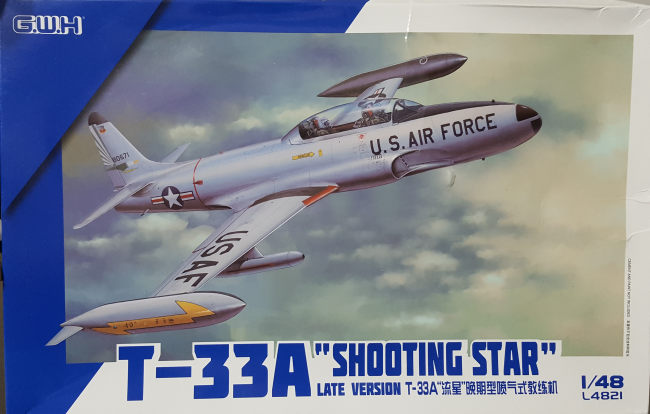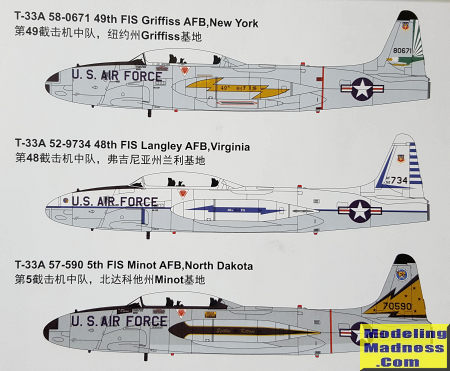
GWH 1/48 T-33 Shooting Star 'Late Version'
| KIT #: | L4821 |
| PRICE: | $36.00 delivered |
| DECALS: | Three options |
| REVIEWER: | Scott Van Aken |
| NOTES: | New tool kit (2016) |

| HISTORY |
The Lockheed T-33 Shooting Star is an American-built jet trainer aircraft. It was produced by Lockheed and made its first flight in 1948, piloted by Tony LeVier. The T-33 was developed from the Lockheed P-80/F-80 starting as TP-80C/TF-80C in development, then designated T-33A. It was used by the U.S. Navy initially as TO-2 then TV-2, and after 1962, T-33B. While there are no more military T-33s still in active service, the type is very popular with the jet warbird crowd. Many T-33s spent over 40 years on active service before being retired.
| THE KIT |
 The
T-33 has always been a somewhat popular subject. Regarding 1/48, in the 1960s we
had one from Hawk that was reissued several times by Testors. Twenty years or so
after that we had a much nicer version from Hobbycraft that was reboxed by
Academy. Nice as it was it was still lacking in the detail we expect today,
though it did not have the big shape issues of the Hawk kit. Now, GWH has
produced a thoroughly modern mold for the T-33 fan.
The
T-33 has always been a somewhat popular subject. Regarding 1/48, in the 1960s we
had one from Hawk that was reissued several times by Testors. Twenty years or so
after that we had a much nicer version from Hobbycraft that was reboxed by
Academy. Nice as it was it was still lacking in the detail we expect today,
though it did not have the big shape issues of the Hawk kit. Now, GWH has
produced a thoroughly modern mold for the T-33 fan.
If you have seen any GWH kit you know that the detailing is excellent. Nicely engraved panel lines and rivet detail, though nothing overboard. I know that some modelers don't like engraved rivets, but they are part and parcel of modern aircraft kits. Most of us do not mind at all. All the parts save the clear bits are in GWH's light grey plastic. Inspection of the parts showed no ejector pin marks that would be visible save perhaps one in the center piece of the main gear well. Gear doors and the face of the inside intake showed some light sink areas that would have to be dealt with, but nothing major.
Reading through the instructions I saw a few areas that made me raise my eyebrows. One is that one was supposed to completely build up and install the nose landing gear early in the construction process. This is, for me, just asking to break bits. It looks like the gear can be installed after painting and that is what I'll do. Another is that all the gear doors, and this includes the speed brakes, are molded shut, requiring the builder to cut them open. I've not seen this on a modern kit in many years.
The kit's cockpit is really nicely done. The one piece tub has raised side console detail, though one could put decals on them if one so wishes. The seats are each seven pieces and while there is no belt detail, they look very nice. Something new to me was that the instrument panels are in two pieces. One is to trap an instrument decal between the two pieces. This will allow one to prepaint the panel and then have glossy instrument faces. It will be interesting to see how this works out. Rudder pedals attach to the back of the instrument panels.
You are provided with pretty long intakes and while there is no engine compressor face, they are long enough to make it believable. There are a few ejector pin marks on the inside of the outer intake pieces so you may want to deal with those. There is a single exhaust tube that has a compressor piece attached to the back. The instructions show the nose gear well attached to the underside of the cockpit and an area to put weight, but no amount is suggested.
Wings are a single lower piece with two upper ones. To pose the flaps lowered, each lower wing side gets four actuating pieces. The main gear well is a single piece with a separate piece between the wells. There are holes in the lower wings for pylons, and these along with aux tanks are included. Not all later T-33s had these pylons so check photos before installing them.
All the control surfaces are separate and while one
almost never saw the flight control surfaces any way but neutral, the speed
brakes were often down and one could also find the flaps lowered while on the
ramp. Landing gear is nicely detailed and as I mentioned, the instructions want
these installed rather early. I suggest leaving them off until later if you can.
The underside of the aircraft has a number of small pieces that fit there
including four little bumps in between the flaps. I have no idea what these are.
Perhaps something to do with air flow. There is an interior piece for the canopy
and the instructions show this in the open position. A nice ladder is
provided as a single piece so no fiddly steps, though one will have some quality
seam removal time ahead of them.

The instructions are a well done booklet with colors provided in both Gunze and MiG shades. A separate sheet for two of the markings options includes the chart for these. Three options are provided. The box art pane from the 49 FIS is in overall ADC Grey, while a 5 FIS option is in unpainted metal upper and ADC Grey undersides. Then there is a 48 FIS aircraft with white upper surfaces and outer wing tip tanks with ADC Grey lower surfaces. The large decal sheet is nicely printed and should work just fine as I've had positive experiences with GWH markings.
| CONCLUSIONS |
If you are wondering what makes this a 'late' aircraft it would be the placement of the pitot tubes and a vent on both sides of the forward fuselage. Note that not all later T-33s had these vents so check your references as you may need to fill those in. Should you not like the markings provided, there have been a number of aftermarket sheets for 1/48 T-33s, and while those were sized for the Hobbycraft kit, they should, for the most part, also fit this one. Note also that you cannot build a Canadair CT-133 out of the box with this kit as that airframe had some different nose scoops/vents and a vent on the aft fuselage.
| REFERENCES |
http://en.wikipedia.org/wiki/T-33A_Shooting_Star
January 2024 Copyright ModelingMadness.com.
All rights reserved. No reproduction in part or in whole without express
permission from the editor. If you would like your product reviewed fairly and
fairly quickly, please
contact
the editor
or see other details in the
Note to
Contributors.